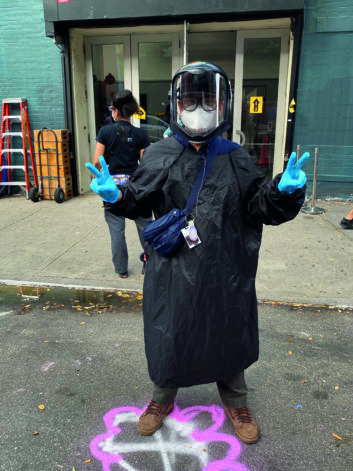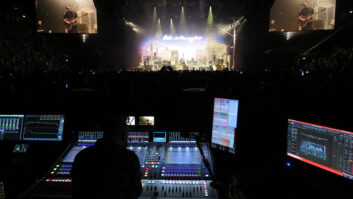One might imagine that at the height of the pandemic film crews were scaled back. But that wasn’t the case, according to production sound mixer Richard Lightstone, CAS, who was working on a production set last August. A typical three- or four-person team (a sound mixer, a boom op or two, and sound utility) expanded to include one more—an assistant to sanitize the equipment every night. “The fear was that they would try to minimize those on-set, but then it turned out that we needed more personnel to make things happen,” he says.

Lightstone is a former board member of IATSE Local 695 and co-editor of the 695 Quarterly magazine, is on the Cinema Audio Society board of directors and served as their President between 2003-2006. He notes that “nothing really changed in the way we made a project, except there was an added level of scrutiny, a level of complexity that slowed down production. But the COVID safety protocols—social-distancing, working in pods, wearing masks and face shields (even actors wore masks during rehearsals and walk-throughs), cleaning the equipment, and staggering the setup so the lighting crew would go on a set and do the work, and then the grips would come in, and then camera department, and so on—were smart in terms of protecting the investment that these studios and producers made in each of these projects.”
Four-time Oscar nominated production sound mixer Tod A. Maitland elaborates on that complexity in his return to the set of director Lin Manuel Miranda’s debut musical feature film Tick Tick Boom. Pre-production in October involved a round of COVID testing, a multitude of online COVID educational videos, and 15 pages of protocol documents. Also, he notes that 30 new people were added to the call sheet in brand new job categories, like COVID safety officer. He says, “We were one of the first films to resume, and Netflix put a ton of money into bringing us back safely. It wasn’t going to be easy but we all appreciated it.”
According to Maitland, the first few weeks of production were restricted to studio shooting only, as location work was still not allowed. Each morning after testing, Maitland would head to his assigned taped-off area, where he and his sound cart spend most of the day. The stage floor was laid out in a checkerboard of taped-off departmental blocks, allowing a 6-foot-by-6-foot space for each person. His block was sized to allow three from his team, and his Pro Tools playback operator, Derek, was in the six-by-six block next door. Each person was given a colored badge—orange for crew who needed to be on set, and red for the crew to be on set when actors were present. Each person was also assigned to a pod (basically, who they spent the most time next to).
The restrictions started first thing each day with the morning blocking rehearsals. “There was fewer crew allowed to watch and be on the set. We were required to wear our colored badge, mask, glasses, and face shields,” Maitland says. “Wiring actors changed radically also, especially in the first few weeks after coming back. The new protocol was that I would meet with wardrobe to check out the actors’ costumes and work out a plan. Then my crew—Jerry Yuen and Terence McCormack—would sanitize a transmitter and lav mic, seal it in a sandwich bag and send it to the actor with the appropriate mic rig for their wardrobe. Many times the actor would put on their own mic; this had varying results, as you could imagine, depending on the actor. Wardrobe helped out a lot here also. For those first few weeks, no one touched anyone. After about three weeks, it loosened up a little and I was able to do the final lav placement.”
He notes that since Tick Tick Boom is a musical with live singing, COVID protocols called for all crew members (and actors) to be 12 feet away from live singers to avoid contact with any droplets propelled out of a live singer’s mouth. When booming a scene, that meant a 12-foot pole was mandatory.
Also for live singing, the crew had to wear face shields, gloves and medical smocks in addition to the normal mask and goggles. “This definitely put a damper on the whole process of live singing,” Maitland says. “On the set, I joked that it looked like doctors making movies; every crew member on stage was dressed as if it were an operating room.”







